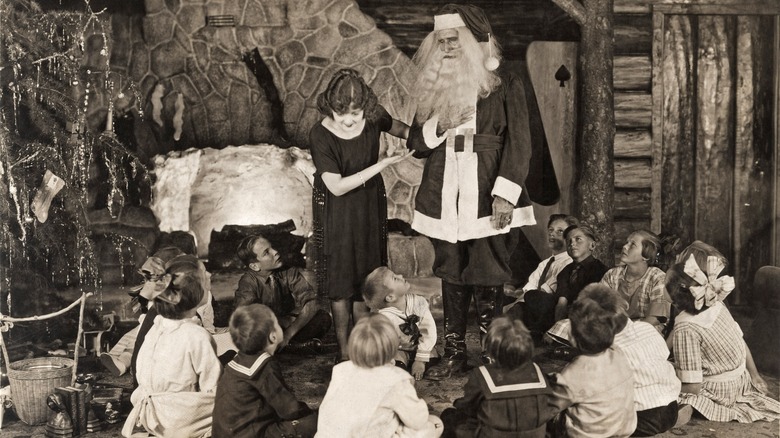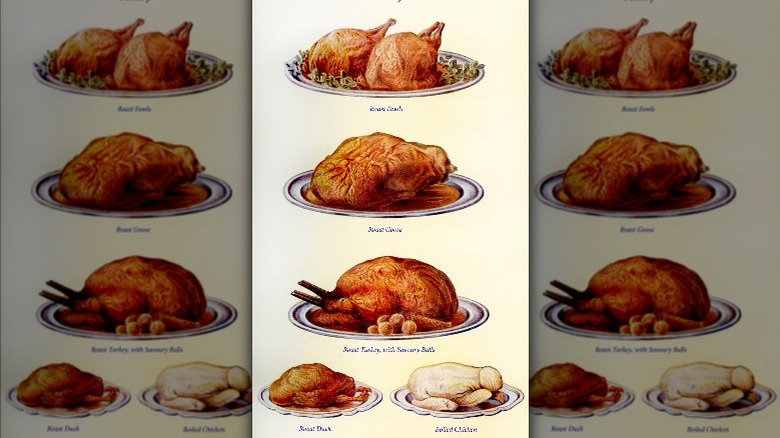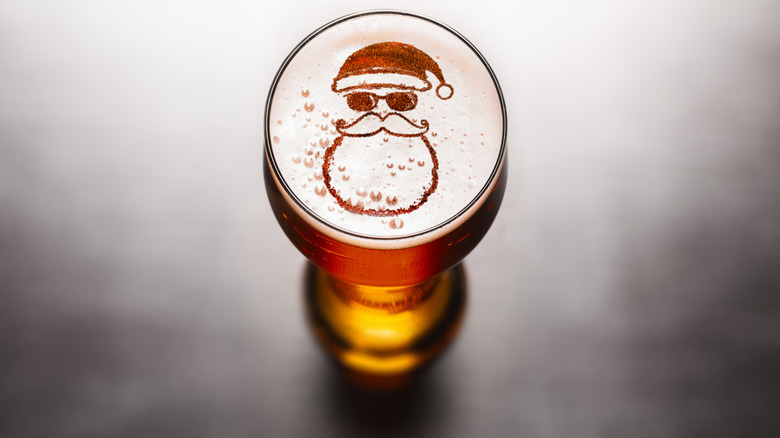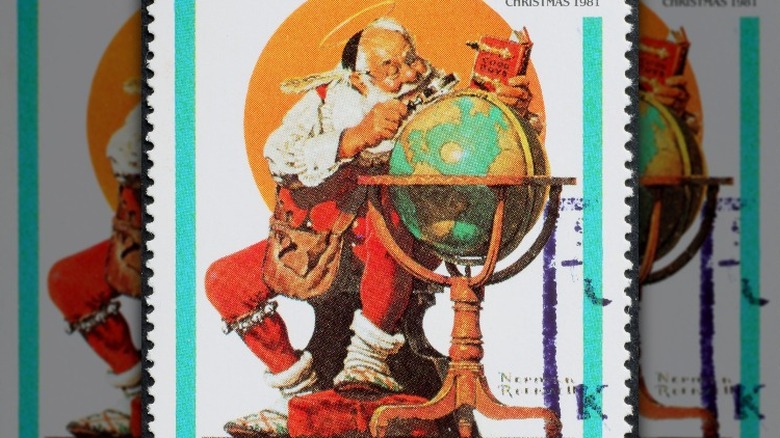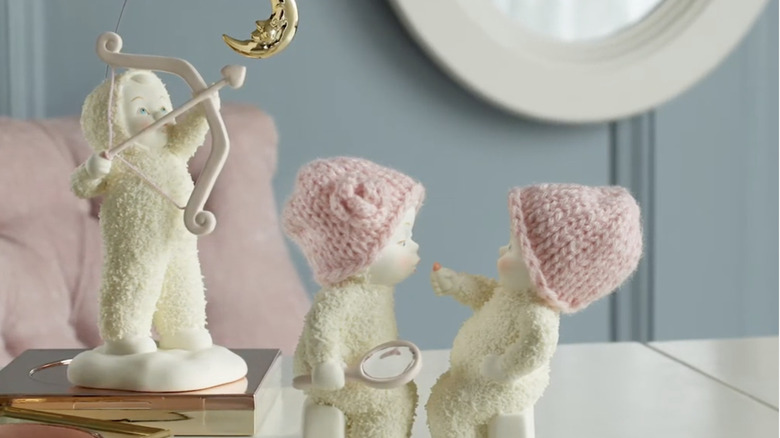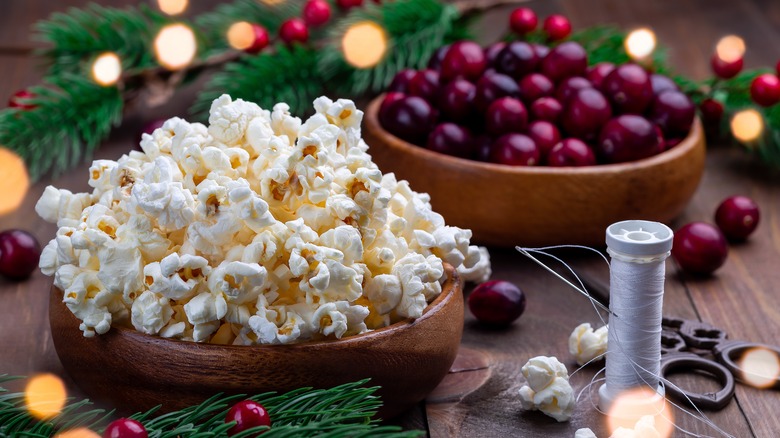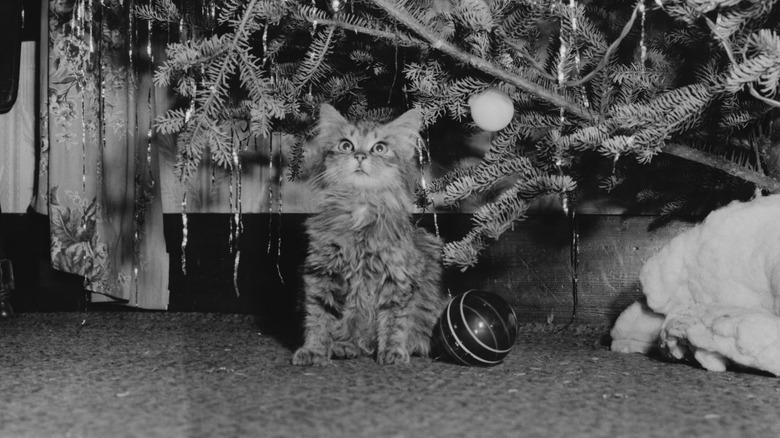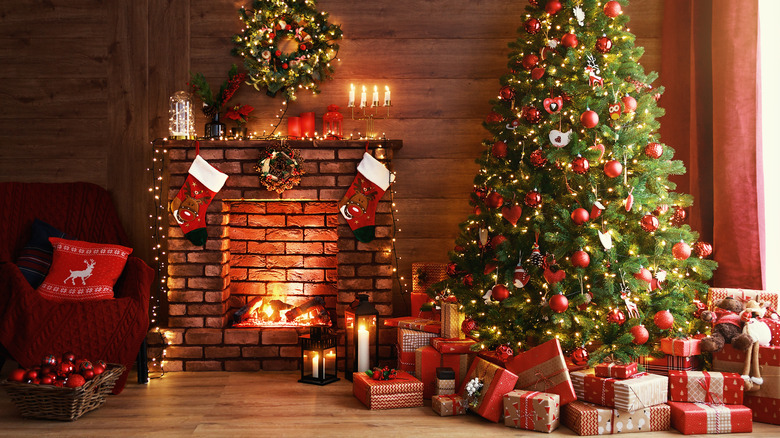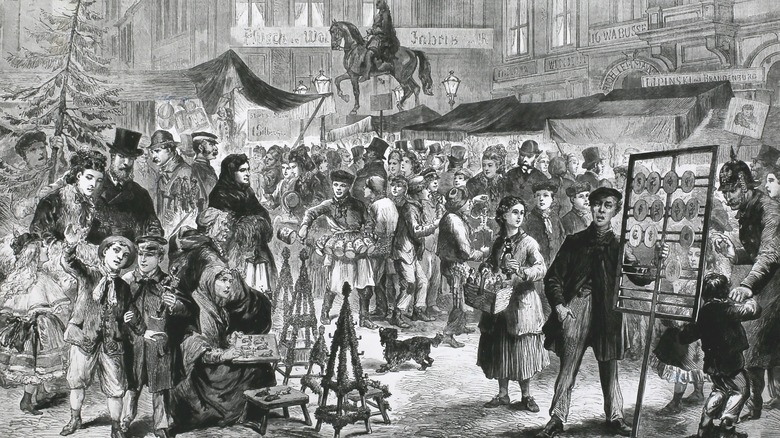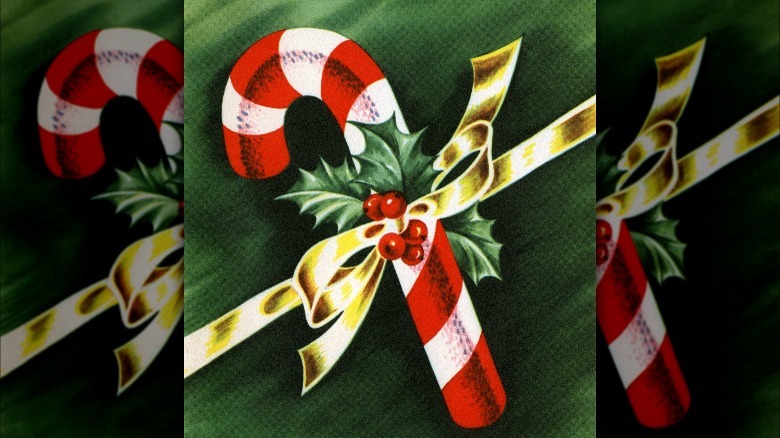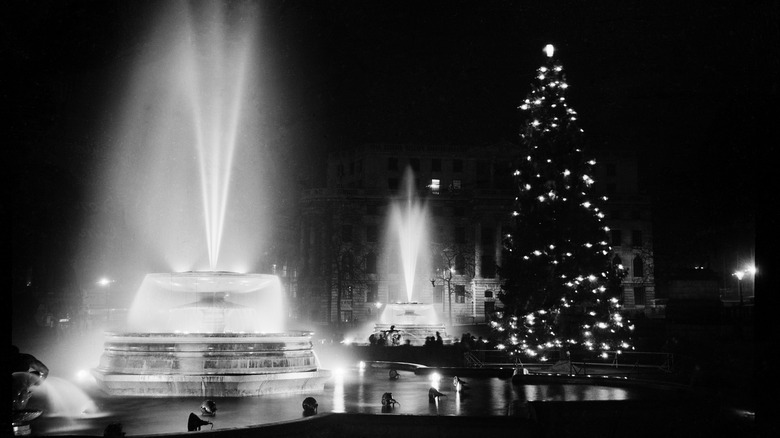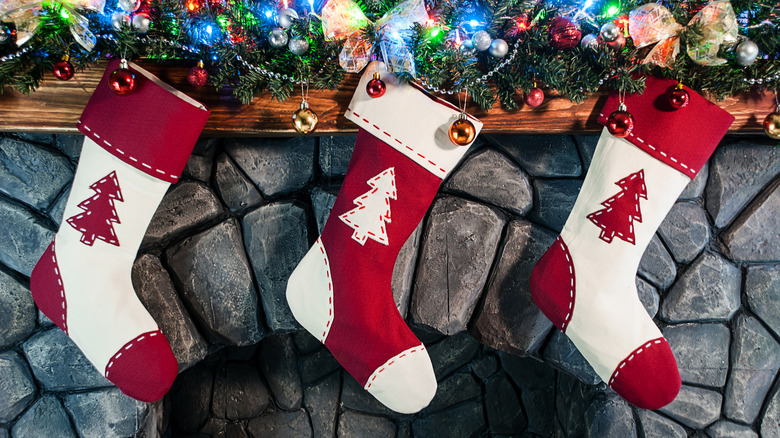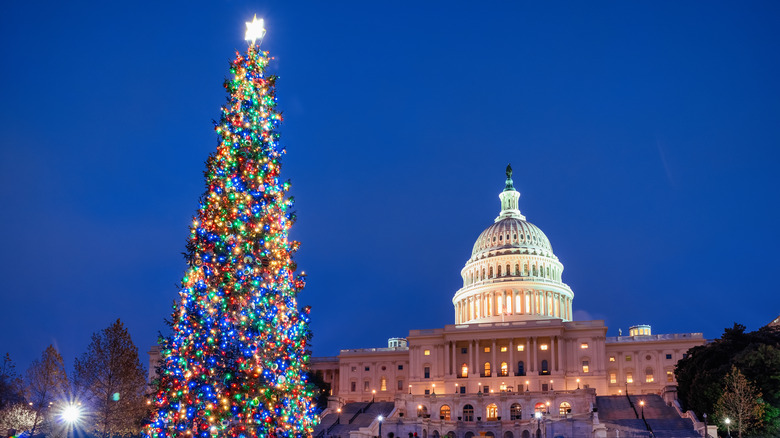Christmas Traditions People Used To Follow 100 Years Ago
From sappy seasonal Hallmark movies to civic tree lightings and the return of Starbucks gingerbread lattes, it's beginning to look a lot like Christmas. And don't forget about nights spent snuggled up by the fireplace listening to Michael Bublé carols while strategizing fresh Elf on the Shelf antics for the kids.
We've all come to associate specific activities and experiences with the holiday season. Many of these activities have been passed down for generations, with each decade putting its unique stamp on an aspect of the holiday.
Take, for example, the 1920s when the world remained in recovery after the Great War. The stock market boomed, and few people had a care in the world about a coming Depression. Not only did this roaring age usher in new traditions, but it also borrowed heavily from the past, guaranteeing a cozy Yuletide season. Time travel into the past with us we explore Christmas traditions popular 100 years ago.
Roasted meat and creative sides
Hands-down, one of the best parts of the Christmas season is the chance to indulge in delectable and seasonal eats and treats, from honey-baked ham to sugar-dusted slices of Bûche de Noël. Decadence proves synonymous with the holidays, and this approach to holiday bliss also reigned in the 1920s.
People living in this decade enjoyed many exciting advances in the culinary realm, including Jell-O (first introduced to the American pantry in the late 19th century) and Crisco, per The History Reader. But some aspects of the Christmas meal stayed highly traditional. This made for a fun and tasty mixture at the dinner table. According to a 1922 issue of Good Housekeeping (via The Food Timeline), mains included tasty treats like roast goose or roast beef mixed with creative sides like oyster cocktails in green pepper shells and celery-and-olive salad in Hubbardston cups.
The History Reader lists other menu options pulled from 1924's "The New Butterick Cookbook." They include treats like English Plum Pudding and Yorkshire Pudding, straight out of "A Christmas Carol," and unique items like White Grape Salad with Guava Jelly. And in true 1920s style, many Christmas cooks included a hefty dose of Hard Sauce, cheerily bucking Prohibition.
Top-shelf smuggling
Celebrating Christmas with a hot toddy dates back to 18th-century Scotland, per Masterclass. As you can imagine, this made festivities during Prohibition a challenge. Lucky holiday revelers received alcohol bootlegged across the border from Canada, according to The History Reader. And prices were through the roof. Getting your hands on a Seagram's bottle could easily cost upwards of $142 in today's currency.
Cutting coveted booze with a little mineral water made sense to stretch it further. That's where brands such as White Rock came into play. This carbonated water company actively advertised their beverage using images of Santa Claus in the 1920s — but with a twist. A little whiskey sat next to his White Rock, making him a jolly elf, indeed (via White Rock Beverages). These advertisements helped clinch White Rock's reputation as a vital part of great alcoholic drinks.
The illegal activity became a sort of annual rite bringing seasonal cheer. But an alcohol poisoning incident in 1926 put a serious damper on the fun, as reported by Slate. In two days, 24 people died after drinking alcohol intentionally poisoned by the government. Known as the "chemist's war of Prohibition," this episode is rarely taught in history classes today. But as the Chief Medical Examiner of New York City, Charles Norris, noted, it represented "our national experiment in extermination." It also made for an unparalleled post-Christmas hangover for those lucky enough to survive the experience.
From Saint Nicholas to Santa Claus
Saint Nicholas' evolution into Santa Claus took centuries, as reported by The Public Domain Review. After all, it's an enormous leap from a severe-looking religious icon to a portly pop culture superhero. But by the 1920s, people referred to the jolly old elf interchangeably at Saint Nicholas and Santa Claus.
As this transition took place, Santa became an inextricable part of the Christmas narrative, eclipsing other more religious aspects. The hearty and hale version of Santa also gained in popularity in the 1920s thanks to the work of Norman Rockwell. Rockwell portrayed Santa in a highly realistic style, cementing his look as a grandfatherly human male rather than a cartoon-like pudgy elf.
While Saint Nicholas originated in Europe, he didn't go through the same evolution on the Continent as he did in North America (via National Geographic). European versions of Santa looked (and acted) much scarier, including Aschenklas, Ru-klaus, and Pelznickel. These characters resorted to beating and kidnapping kids who behaved poorly. Fortunately for European kids, by the 1920s, the North American Santa reverse-migrated back to the Old World, revealing a softer side. As "Santa Claus: A Biography" author Jerry Bowler argues, today's Santa is a welcome respite from the vicious supernatural being who once populated children's nightmares.
Snowbabies
By the late 19th century, another common Christmas tradition got added to the slate, collecting and displaying Snowbabies. First manufactured by Hertwig and Company of Thuringia (in modern-day Germany) in the 19th century, these adorable holiday figures are crafted from bisque and covered in icy snow (glitter sand) to look like they're midway through a playdate in a winter wonderland (via Kovels).
According to the collectible experts at Live Auctioneers, Snowbabies originally came from Germany and functioned as cake toppers. The figurines were covered in crystallized sugar, giving them an icy look. But soon, the company realized the collectible potential, and they began working in more permanent materials.
These adorable sculptures soon found their way onto Christmas trees and fireplace mantles as holiday décor. By the 1920s, they were staples of the tree and mantle, both in Europe and the United States. Japan also got in on the collectible craze, creating versions of the dolls that exploded in popularity. Besides their obvious associations with the winter months, some figurines also had a current event angle, such as those created to commemorate the 1906 Race to the North Pole between Robert Peary and Dr. Frederick A. Cook, per Popular Mechanics. The focus on athleticism and record breaking in the 1920s would have made such items especially popular (via Encyclopedia).
Paper decorations and DIY crafts
At the end of the 19th century, crepe Christmas decorations proved all the rage. They remained a favored decorating material in the 1920s, according to Sauder Village. Booklets detailing how to create Christmas decorating staples came from the Dennison Manufacturing Company. Some of these booklets took the paper décor craze next-level, describing how to create crepe dresses! But the holiday esthetic didn't stop at paper.
Yuletide expressions meant other DIY decorations, too. Families bonded over paper chains, stringed popcorn and cranberry garlands, and cut-out snowflakes. According to Parade, the first references to such decorations date back to 1842 and Phillip Snyder's "The Christmas Tree Book." Snyder details the first Christmas tree's look in the book, boughs filled with paper decorations, nuts, and popcorn. A shiny gold star provided the finishing touches.
While it's a bit harder to pinpoint when cranberries first got added to the tree decor, we know they were grown for produce in Cape Cod near the beginning of the 19th century. With their vibrant scarlet color and tendency to stay well-preserved for months, they made for an attractive and convenient addition to the Christmas tree.
Some decorations were dangerous
Besides crepe decorations and DIY crafts, Christmas décor also came boxed and ready to go from the store. One hundred years ago, the same emphasis on customer safety didn't exist, however. As a result, people living in the 1920s sometimes ended up with pretty, though dangerous, additions to their Noel repertoire.
Among the most notorious and popular was Lametta tinsel, according to ACS Chemistry for Life. Patented by the German company Stanniolfabrik Eppstein in 1904, these shiny metallic strands decorated stylish trees in the 1920s. But the evergreen bling hid a dark secret. Manufactured from lead alloy foil topped with tin bonding, this decoration came with the real threat of heavy metal exposure, especially for babies, small children, and pets. But nobody thought too much about this 100 years ago. In fact, addressing the lead tinsel issue wouldn't happen until the 1970s, as reported by The Atlantic.
Pretty alternatives to the lead décor did exist. These decorations swapped the lead for aluminum. But they proved highly flammable because underneath all the sparkle they were made with paper. While this might not sound too scary in and of itself, remember that many people still lit their tree with real candles.
White elephant traditions
Whether you refer to it as white elephant, dirty Santa, or Yankee swap, the popular Christmas party game proved well established by the 1920s, according to Mental Floss. These "swap parties" had two decades under their belt when the Roaring Twenties rolled around. But it wasn't until 1901 that they grew in popularity.
This rise in popularity originated with an article that appeared in the Hartford Herald in Kentucky (via Chronicling America). It laid out the rules of the game, recommending having at least "four or five little bundles, wrapped so that no one else can suspect the contents." The article also counseled participants to wrap the most ridiculous and bizarre items they could ascertain. In a fun twist, the person that ended up with the most unwanted gift had to perform. Literally. Mental Floss reports the losing participant needed to tell a story, sing, or find another way to entertain their fellow Christmas revelers.
The name for this party activity has its roots in a fascinating legend from Thailand, as reported by Reader's Digest. This myth claimed the king of Siam would gift those who displeased him with the rarest and most expensive of items, an albino elephant. And by expensive, we're talking pricey to care for. This would result in the recipient's financial ruin. Although since debunked, the colorful story ensured the name stuck. And the 1920s cemented it as a regular part of the holiday season.
Christmas markets
European Christmas markets date back to the late 13th century, when locals held the first Krippenmarkt during the Advent in Vienna, Austria, according to The Guardian. When reformer Martin Luther came on the scene, these December markets got an additional boost because of his suggestion that Christmas, a celebration of Jesus' birthday, proved a better time for gift-giving than holidays commemorating saints alone.
By the 1920s, Christmas markets proved highly popular once more, mounting a comeback after World War I. They may have provided a sense of comfort and normalcy for Europeans still recovering from the conflict. As the National WWII Museum points out, millions had died in the years-long conflict. For those who remained, it must've felt refreshing to return to happier pre-war traditions.
The markets featured stalls selling everything from bratwurst and spicy mustard to hot-spiced wine, gingerbread, and candy canes (via Rick Steves). These events would have provided a wonderful respite from the horrors of the recent past, not unlike the wonderful, albeit brief, Christmas truce of 1914 between British and German forces just a few years before (via Smithsonian Magazine).
Candy canes
It's hard to imagine a confection more closely associated with Christmas than candy canes. The red-and-white-striped treats decorate everything from mugs of hot cocoa to stockings and trees. According to The Conversation, 90% of these pepperminty delights get sold between Thanksgiving and Christmas. And they remain the most popular candy, apart from chocolate, throughout the holiday season.
The vaunted history of candy canes allegedly dates back to the 17th century when a German choirmaster started handing out the treats to kids to help them get through lengthy nativity services. The iconic shape of the sweets may have come from the shape of the shepherd's staff since Jesus is associated with the "Good Shepherd," as reported by Christianity. That said, others claim the hook made the treats easier to hang from the tree. The first legit mention of Christmas candy canes happened in 1847 when a German-Swedish immigrant named August Imgard described decorating his tree with them.
While some people claim these beloved peppermints didn't officially get their stripes until the 1920s, National Geographic has done a good job of debunking these claims. But the 1920s did see advances in candy cane manufacturing thanks to Bob McCormack, founder of McCormack's Famous Candy Company in Albany, Georgia. Along with his brother-in-law, Father Gregory Keller, they invented a machine that automatically put the hook in each candy, leading to skyrocketing production rates 100 years ago.
Twinkling lights
Chevy Chase put the extreme in Christmas light décor. But the tradition of Christmas illumination dates back centuries. Quoting the "Golden Glow of Christmas Past," Time notes that Christians used candles to "signify the light of Jesus." But between highly flammable paper decorations and trees that turned into veritable kindling as they dried out, keeping up this tradition came with significant risks.
Luckily, a much-needed upgrade came with the advent of electric decorative lighting, first developed in the 1880s by Edward Hibberd Johnson (via Smithsonian Magazine). As early as 1895, President Grover Cleveland trimmed a White House tree with the stuff, effectively introducing the glittering strands to the public.
But the high-tech decorations remained outside many people's budgets until the 1920s. That's when General Electric started manufacturing cheaper and more accessible pre-assembled lights, according to Time. Thanks to the 1920s and advances in mass manufacturing, more than 150 million light sets illuminate 80 million homes in the US today, according to Smithsonian Magazine.
Oranges
The idea of Christmas stockings hanging by the fireplace dates back centuries, but what Santa placed in these decorative socks has changed over the decades. In the 1920s, the jolly elf stuffed them with candy canes, fruits, and nuts. But receiving a bright, juicy orange remained the height of the stocking fun, as reported by Smithsonian Magazine.
The mass marketing of citrus as stocking stuffers didn't reach its heyday until the early 20th century ... 1908 to be exact. That's when the California Fruit Growers Exchange started to promote its Sunkist label heavily. In a piece about the citrus industry by Tom Zoellner for the Los Angeles Review of Books, he notes, "[N]early 1,500 Manhattan retail stores and soda fountains had bright orange advertisements plastered in their windows. At Christmas, a cartoon Santa Claus offered an orange as the 'most healthful gift.'"
The orange fury would persist into the 1930s and beyond. After all, it represented an affordable luxury meant to keep the family in tiptop health. What's more, the supply chain wasn't very intricate in the 1920s, which meant people living in rural areas had little experience with most citrus outside of the holidays. Of course, other edibles such as candies and nuts could also fill the bill.
The National Christmas Tree
The first community-wide Washington, D.C., Christmas celebration took place in 1913, as the National Park Service reports. Like the annual celebrations we see today, it involved caroling kids and a performance by the US Marine Band. All told, between 20,000 and 30,000 people gathered for the first event.
This event would see a significant upgrade by 1923 when President Calvin Coolidge gave the Yuletide spirit a boost with the first National Christmas Tree lighting (via National Geographic). The inaugural event featured a Balsam Fir measuring 48 feet and covered in 2,500 electric lights. The lights used to decorate the tree included green, red, and white hues.
Electric Christmas lights have become an inextricable part of the nation's celebrations at the Capitol and on the White House lawn. These events include lavish entertainment and massive crowds ushering in the holiday spirit. This year marks the 99th Christmas tree lighting at the White House. According to ABC News, the specimen came from Middleburg, Pennsylvania and is embellished in red and white lights, a nostalgic nod to Coolidge's original tree.
